Inside NYC’s Public Housing, Mold and Neglect Are a Dangerous Combo
The New York City Housing Authority has failed to comply with court orders to remedy unhealthy living conditions. But tenants and advocates refuse to let the nation’s biggest residential landlord off the hook.
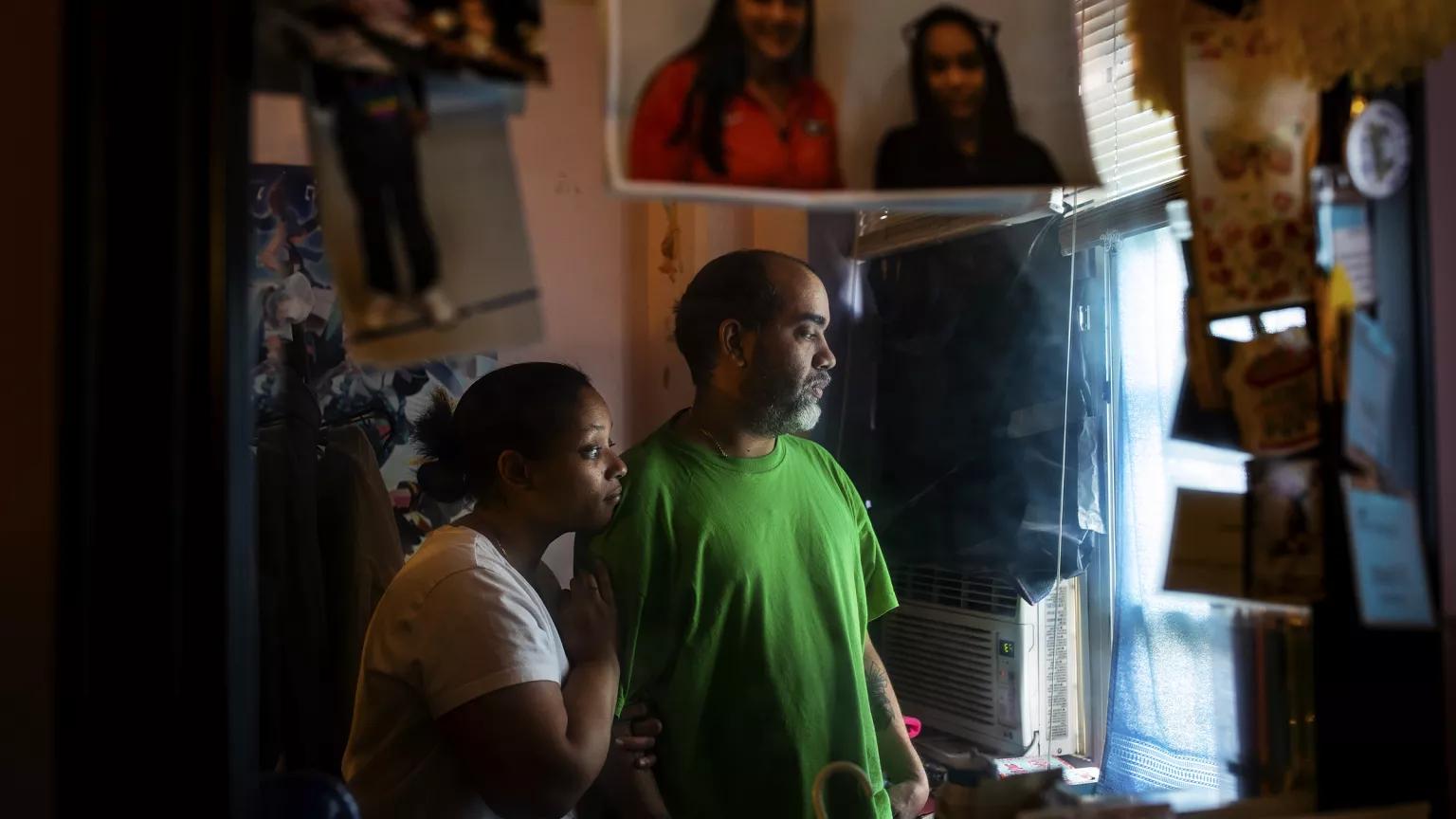
Demetrius Freeman for NRDC
Sit back for a moment and imagine not being able to breathe in your own home. Imagine waking up in the middle of the night gasping for air or, worse, hearing your child, at any hour, wheezing, coughing, unable to fill her lungs. Imagine medications and breathing machines, emergency room visits, hospitalizations—all stemming from a menace in your own home that no one is willing to address.
For decades, this has been the unfortunate reality for many New York City residents whose public housing apartments have been plagued by rampant and recurring mold, caused by unchecked leaks and moisture. Despite pleas from tenants and community leaders, and even orders from a federal court, the New York City Housing Authority (NYCHA)—the nation’s largest residential landlord—has failed to properly identify and fix the problems, leaving residents to suffer.
This mold has exacerbated, and in many cases caused, asthma and other respiratory illnesses in tenants. It adds to a problem already acutely felt by these apartment dwellers; as it is, asthma inordinately affects low-income people of color, especially in the New York City neighborhoods where the mold problems are occurring. Asthma rates in the South Bronx, for example, are eight times higher than the national average, and more than 8 percent of children in the Bronx suffer from the chronic lung disease.
“One of the most heartbreaking things is some residents feel like they can breathe better with their windows open—even when their apartments are next to industrial facilities, landfills, and highways,” says Sara Imperiale, an NRDC staff attorney who focuses on environmental justice issues. “It really is a civil rights issue. Folks have the right to breathe in their homes.”
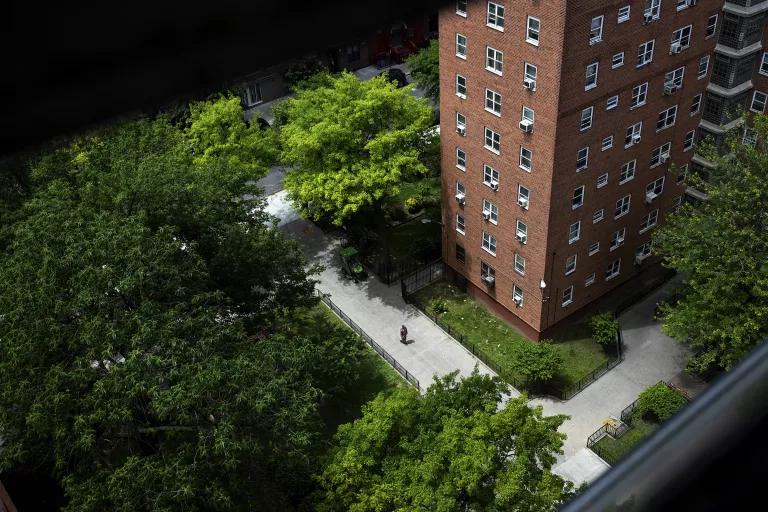
The view from the Ramirezes’ apartment to the NYCHA complex below; negligent repairs have plagued the family for nearly a decade.
Demetrius Freeman for NRDC
Groups like Manhattan Together and South Bronx Churches, local affiliates of a national community-organizing network called the Industrial Areas Foundation (IAF), agree. For decades they have been helping tenants to organize and press NYCHA to make repairs. While the groups did force the housing authority to make thousands of repairs, by 2011 it became apparent that large-scale change was needed, and that legal intervention was necessary to make it happen. So IAF approached NRDC with the issues, and in December 2013 NRDC and the National Center for Law and Economic Justice filed a class-action lawsuit, Baez v. New York City Housing Authority, on behalf of the tenants, Manhattan Together, and South Bronx Churches.
They reached a settlement with NYCHA that required the housing authority to respond to issues quickly and stop addressing tenants’ mold problems with superficial fixes, such as painting over or applying bleach to the walls. Importantly, as part of the agreement, NYCHA admitted that the underlying cause of the mold was moisture—meaning the city would need to address the problem at its source—and acknowledged that asthma is covered under the Americans with Disabilities Act. Under that federal law, public entities, including local government services like NYCHA, must make reasonable accommodations to provide equal access for individuals with a disability. For asthma, these accommodations included modifying NYCHA’s mold remediation policies.
Fast-forward two years to 2015, and not much had changed for the tenants: The mold remained, and NYCHA wasn’t holding up its end of the deal. The groups went back to federal court to enforce the agreement; a judge reviewed the case and concluded that the housing authority had been out of compliance from day one of the settlement. In early 2016, the judge appointed an independent authority, called a “special master,” to oversee NYCHA’s future compliance.
What followed were more than two years of apartment inspections, studies, and pilot projects under the oversight of the special master. In April 2018, the groups went back to court with an amended settlement agreement to seek the court’s approval. Imperiale and leaders from Manhattan Together feel hopeful that if the court approves the settlement, it might finally represent a turning point. The proposed agreement includes the appointment of an ombudsperson who can address individual tenants’ concerns and has the power to hire an independent contractor to do the work, at no cost to the tenant, if NYCHA fails to adequately make repairs.
“There are nearly half a million people who live in NYCHA apartments across the city,” Imperiale notes. “It's not tenable for local community leaders to take every single resident with a mold problem to NYCHA officials and escalate it. So the idea of the ombudsperson is to make the system more sustainable for everybody.”
Other significant pieces of the new proposed agreement include the appointment of independent mold and data analysts; protocols for how to fix and eventually prevent mold problems (using moisture meters, fungicidal paint, mold-resistant construction materials, pipe insulation, and roof fans); measures to ensure honest reporting (NYCHA had filed false paperwork on lead inspections in the past); and protection from repair delays due to capital improvement plans.
Most recently, on June 11, 2018, federal prosecutors in Manhattan, armed with evidence Metro IAF leaders helped them gather, decided to step in and filed a complaint against NYCHA for not complying with federal health and safety requirements, including those related to lead paint, inadequate heating, and mold and pest infestations. Along with the complaint—United States v. NYCHA—the prosecutors filed a proposed consent decree that includes the appointment of a federal monitor to oversee NYCHA’s efforts to address these health threats in its buildings. The consent decree envisions that the federal monitor will coordinate with the special master appointed in the Baez v. NYCHA case, and the case has been assigned to the same judge. The city also agreed to allot an extra $1 billion to NYCHA over the next four years, and $200 million per year after that until a judge ends the decree.
The amended settlement agreement and the consent decree are certainly promising, but they won’t soon fix the erosion of trust between long-suffering residents and their landlord. Below, several NYCHA tenants, and the community leaders and organizers with Manhattan Together who are tirelessly working to help them, share their stories.
***
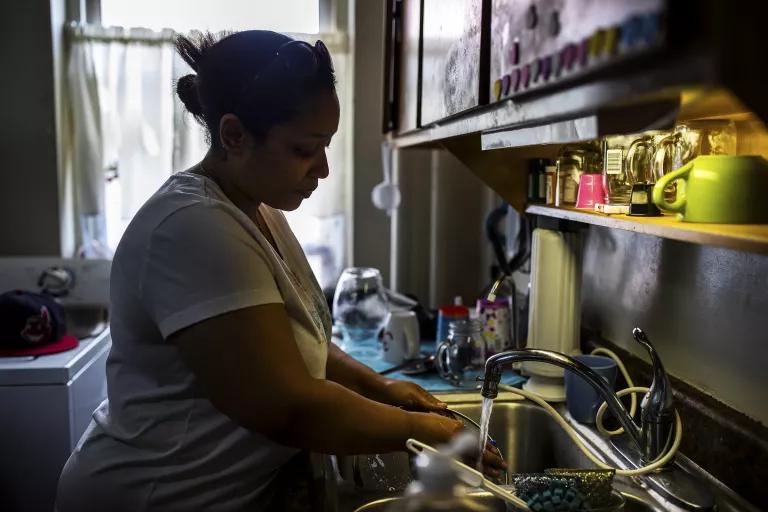
Shaly Ramirez washes dishes in her apartment.
Ayliphelet Ramirez
Resident, Johnson Houses, East Harlem
“I try not to keep them in the house.” Ayliphelet Ramirez, a mother of 9- and 13-year-old girls, is not referring to chips and candy. She’s talking about her daughters. The resident of the Johnson Houses in East Harlem, who goes by Shaly, has been dealing with recurring moisture and mold issues in her family’s apartment—and battling NYCHA’s failure to properly fix them—since the year her youngest daughter was born.
“They just slap a Band-Aid over the problem, turn a blind eye, and hope that the Band-Aid holds. But it never does,” Shaly says, describing the housing authority’s negligence. She and her husband first suspected they had an issue after noticing an odor coming from the closet in their girls’ bedroom. NYCHA denied there was a serious problem, but the Ramirezes persisted, calling at least twice a week, until the agency—after several attempted cosmetic fixes in the closet and the bathroom—finally admitted the possibility of a leak and opened the walls in the apartment to locate it.
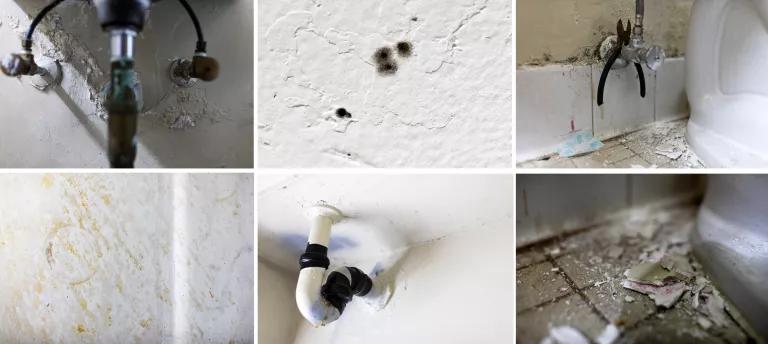
Details of damage in the Ramirezes’ apartment include leaking pipes in the bathroom ceiling and under the bathroom sink, as well as mold spots and rust stains on the walls and peeling paint on the floor.
But even that didn’t resolve things for the Ramirez family. “Here I am a year later with big holes in my wall, and nobody has come,” Shaly says, her frustration apparent. Even with the holes covered up, the smell of mold seeps out. Her daughters, both of whom suffer from asthma so severe they’ve been hospitalized on a few occasions, have had to move into the guest room, where they share a bed—a particularly challenging situation for the younger girl, who is autistic and struggles with separation anxiety. “Now she’s regressing and doesn’t want to be separated from her sister again. Makes for really uncomfortable days when she’s having meltdowns,” Shaly says. The girls also stay at their grandparents’ place on the weekends in order to minimize their time in the mold-infested apartment.
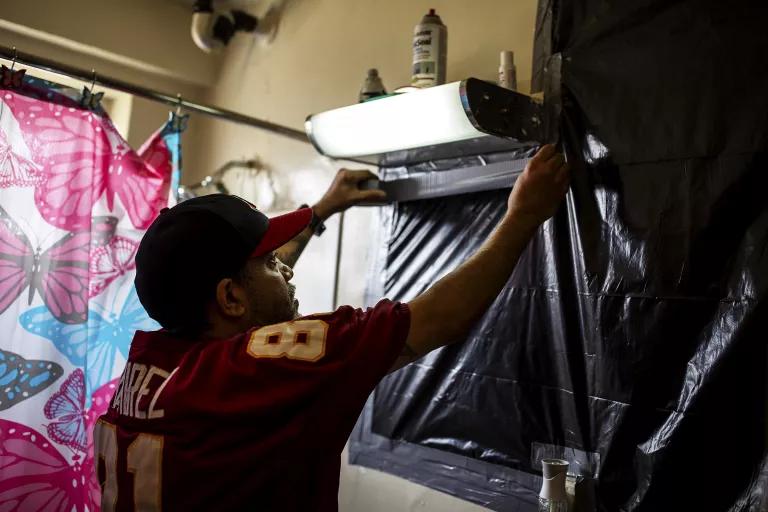
A worker left a hole open and pipe leaking in the Ramirezes’ bathroom wall after coming to repair the mold. Here, Juan Ramirez tapes trash bags over the hole to try to stem the smell of mold.
The Ramirezes remain committed to getting NYCHA to finish the job. “My husband calls the housing office at least twice a week. I check every single day to make sure our work order tickets are still open because they have burned us in the past,” Shaly says.
After dealing with the problem for nearly a decade, she admits it’s become just a regular part of life. “I hate to say it, but when we walk in the bathroom or we walk in the girls’ room, we don’t even see the damage anymore. It’s been there for so long. It doesn’t stop us from calling every week, but it’s sort of become part of the furniture, so to speak.”
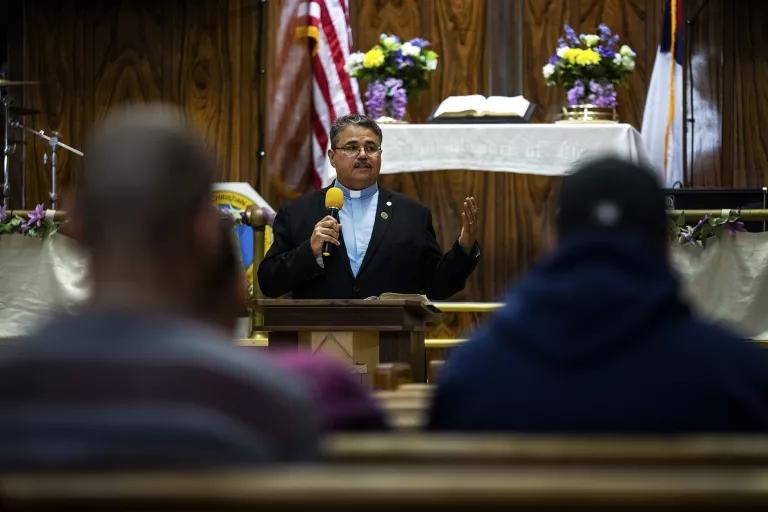
Reverend Getulio Cruz Jr., or Pastor Getty, preaches at the Monte Sion Christian Church in Manhattan’s East Village.
Reverend Getulio Cruz Jr.
Pastor, Monte Sion Christian Church
Pastor Getty, as Reverend Getulio Cruz Jr. is known, is frustrated. It’s frustrating, he says, to see NYCHA tenants try their best to keep a tidy, welcoming home and a healthy environment for their families while being unable to control the moisture, leaks, and mold in their apartments. “They have all the awards their children received prominently displayed in their living rooms. Everything is so nice and clean,” he says. “And then you see the bathrooms.”
It’s also frustrating that with all the attention he and organizers from Manhattan Together have brought to the problem—they won enforcement of their federal case, after all—it’s not being resolved. “We’re not really seeing the positive results of all of our good efforts,” he says. “That makes me angry. I grieve for that. I want to see change.”
The Pentecostal pastor of the East Village church, half of whose congregants live in public housing, started working on the issue in 1999, just two years after helping to found Manhattan Together. Perhaps one of the group’s most effective strategies for building support and pressing for change around the mold problem has been to convene regular assemblies that draw together hundreds of people—and typically include a person who has the power to do something about it. “That way, they see we have people,” Cruz says, referring to NYCHA, and noting that members of the press also attend. “NYCHA doesn’t respond unless they have pressure.”
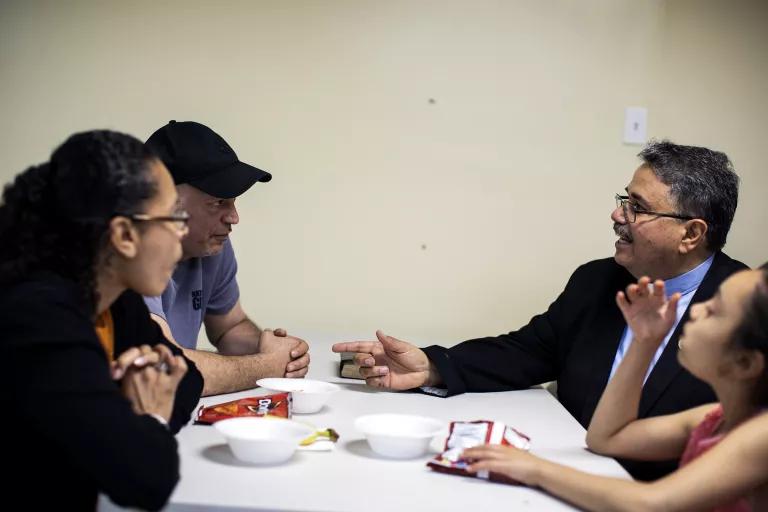
Pastor Getty with parishioners after Sunday services; half his congregants live in public housing.
After nearly two decades of working on this issue, he is adamant that the housing authority needs a serious culture change. “They don’t respect the tenants, plain and simple,” he says. “They treat them like second-class citizens. Anyone who has knowingly and maliciously exposed NYCHA residents to life-threatening lead and mold conditions should be indicted.”
Despite his frustrations, however, Pastor Getty is cautiously optimistic that things could begin to shift, with changes in the agency’s leadership (in April its beleaguered chairwoman stepped down and an interim chairman took over) and the introduction of an ombudsperson to oversee the repairs. “And it’s not just about throwing money at the problem,” he says. “It’s about holding NYCHA accountable for doing good things with that money—for being resourceful and effective.”
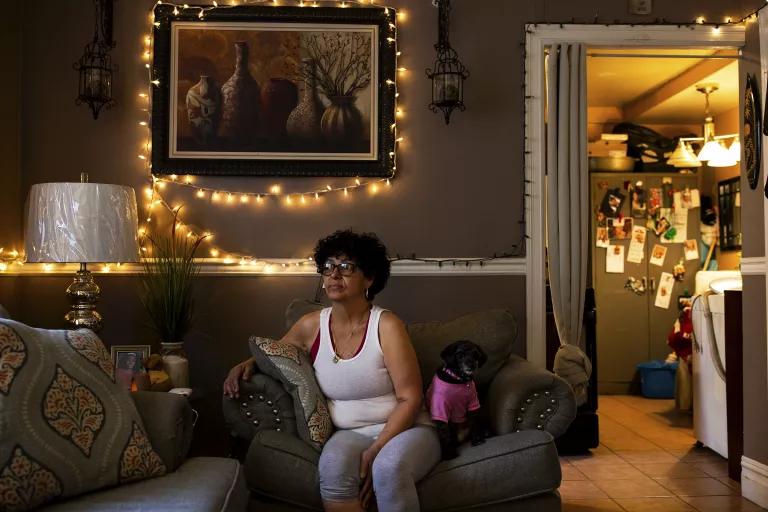
Awilda Garcia sits in her apartment at the Wald Houses in New York’s East Village.
Awilda Garcia
Resident, Wald Houses, East Village
Awilda Garcia has one simple question for NYCHA: “Why?” The 61-year-old wants to know why, after 11 attempts in as many years, the housing authority won’t do the necessary work to remedy her bathroom’s mold problem once and for all. “They come and they clean the mold off—well, they’re really just spreading it around—and they paint it. Six months later it comes out again,” she says. Garcia has been imploring the agency to rip out the panel of her bathtub enclosure where the problem is originating. Even after the prodding of Pastor Getty and Winston Lofton, an organizer with Manhattan Together, NYCHA has so far refused to act.
The negligence has taken a steep toll on Garcia, who was diagnosed with asthma in 2014 and also suffers from high blood pressure and, now, anxiety. “I’m seeing a psychiatrist; I’m on antidepressants and everything. Because this is too much. It is very overwhelming,” she says. The grandmother of 10 has taken to cleaning the mold herself before the youngest of the bunch come over. For years she’s limited herself to taking quick showers with the bathroom door open in an attempt to minimize her exposure to the mold. And on most weekends, she stays at her son’s place, where she’s able to sleep without gasping for air and to shower without worrying it’s going to make her sicker. “I have an apartment I’m paying for, but I’m never here,” she says. “It doesn’t make sense.”

Details of damage in Garcia’s apartment show mold on the walls and peeling paint.
And the mold issue isn’t her only beef with NYCHA. She is a victim of domestic violence, and although the abuser moved out three years ago, the housing authority has yet to remove his name from the apartment’s lease—and adjust her rent accordingly. Garcia has been pleading for the change since the day he left.
She’s understandably fed up with the housing authority. “They just don’t care,” she says. And even with the improved terms of the new settlement, she’s not particularly optimistic. “That’s just the way housing is. I’ve gone to rallies, I’ve already gone everywhere I can go—and nothing.”
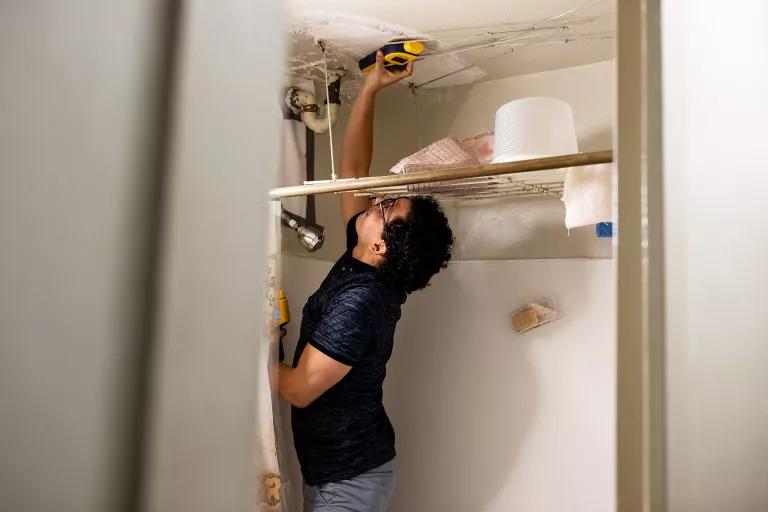
Ray Lopez, director of environmental health for LSA Family Health Service, uses a device that reads moisture levels during a home visit at Manhattan’s Taft Houses.
Ray Lopez
Director of Environmental Health, LSA Family Health Service
Ray Lopez speaks in a calm and even way, exuding a patience fundamental to his line of work. Since 2001, Lopez has worked with the East Harlem–based Little Sisters of the Assumption Family Health Service, helping people struggling with asthma to improve their indoor air quality and reduce the triggers that can lead to attacks. And although he enjoys working on a personal level with households in the neighborhood, Lopez has broadened his mission to address the larger mold and moisture issue plaguing public housing apartments across the city, linking up with Manhattan Together to pressure NYCHA to begin making the necessary repairs.
“Months into this job, I realized that while it’s nice to help one family at a time, I couldn’t ignore the reasons why people were stuck in these kinds of conditions,” he says. “And I quickly realized I couldn’t get NYCHA’s attention on my own.”
Working in tandem, Lopez and the Manhattan Together organizers were able to expedite repairs for some families suffering from rampant mold problems. He says it was rewarding to invite tenants to meetings with NYCHA representatives where they could share their stories. By bringing their concerns out into public forums, Lopez says, the residents were able to hold officials accountable. Despite some heartening cases, however, over time the quality and the timeliness of those repairs went downhill, leaving them no other option than to pursue litigation.

Details from Lopez’s visit to a Taft House apartment show moisture stains under a sink, peeling paint in a child’s bedroom, and a repaired section of a ceiling left unpainted.
Lopez notes that although they still feel frustrated by the relative lack of progress, the tenants in his community do have more tools available to them—namely, advocates like Lopez who now know how to navigate the system, and who have a direct line to legal help and New York City’s Department of Health—and they are often eager to share information with neighbors. They also feel good about shining a brighter light on the mold and asthma issue and to have gained some leverage over the housing authority to be more responsive.
“It’s been a very long game,” Lopez says. “None of these things have quick solutions. But I think we’ve done well with the options in front of us. There’s nothing really you can do except be positive, encouraging, and just not give up.”
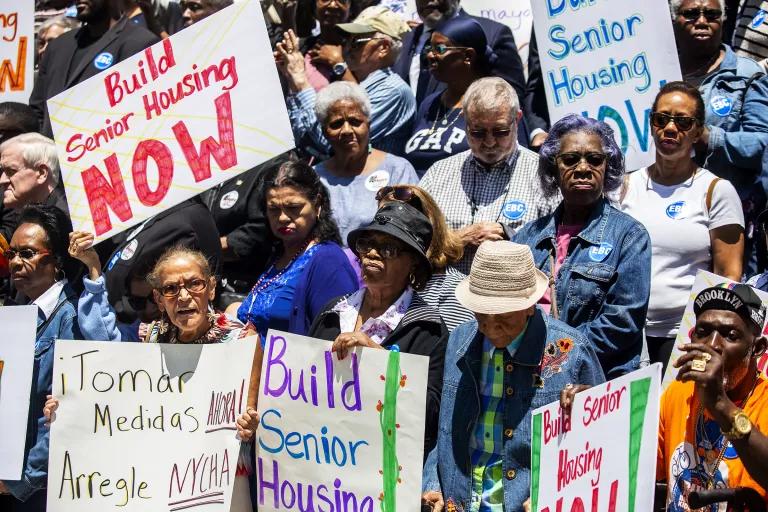
Community members rally at New York’s City Hall to voice concerns about senior housing and NYCHA repairs, June 12, 2018.
Patricia Gorritz
Resident, Alfred E. Smith Houses, Lower East Side
When a NYCHA official called Patricia Gorritz in April 2013 to say the agency had a new apartment for her, she thought it was a prank. “They never call for anything,” she says. “They always send letters.” Soon after, she traveled from her East Harlem apartment in the Taft Houses to check it out. By May, Gorritz and two of her children, then 10 and 12, were living in a three-bedroom apartment in the Lower East Side’s Smith Houses.
“They moved me out as fast they could—I think to shut me up,” she says. Since 2003 she had taken NYCHA to court five times to force the housing authority to fix her rampant mold problem. She’d also been working with the television newsmagazine Dateline to air a story on the authority’s negligence. “I just fought, fought, fought—and here we are. I was also willing to relocate. The rest of the tenants with similar problems wanted to stay. I said ‘I want out.’”
Gorritz first noticed a wall of black mold in a bedroom in her uptown apartment in 2003 after moving some large furniture. She was experiencing a difficult, high-risk pregnancy at the time, and she was worried not only about bringing a new baby into that environment, but also about the harm the mold could have already caused.
Because of NYCHA’s quick fixes—superficial cleaning with bleach and then painting—the problem returned every year. Gorritz recalls that her children were constantly sick throughout their time in the Taft Houses—first with upper respiratory infections and eventually with severe asthma. It got so bad that the Department of Health got involved (thanks in part to Ray Lopez’s assistance) and found the indoor airborne mold levels were significantly higher than what is considered acceptable. (Although there are no national or international standards for mold evaluation, inspectors take air samples inside and outside of a property and work with labs to compare the concentrations of fungal spores in each to draw conclusions.)
The conditions are better in their new apartment, Gorritz says, and everyone’s health has improved. But their new situation is far from perfect. Brown spots frequently appear in their bathroom, and the tub caulking also turns black. Gorritz now knows to be vigilant and, once again with Lopez’s help communicating with NYCHA, the agency has sent workers to clean and paint her bathroom three times in five years.
They haven’t kept up with the overall maintenance of her building, however, she notes. In the hallways, filthy walls and floors and a permeating odor make Gorritz worry that conditions in the Smith Houses could be making her family and other tenants sick.
“I’ve been putting in my complaints, and same old,” she says. “Their responses should be a lot better. No one should be living under these conditions. I’m just praying one day I wake up and everything is fixed.”
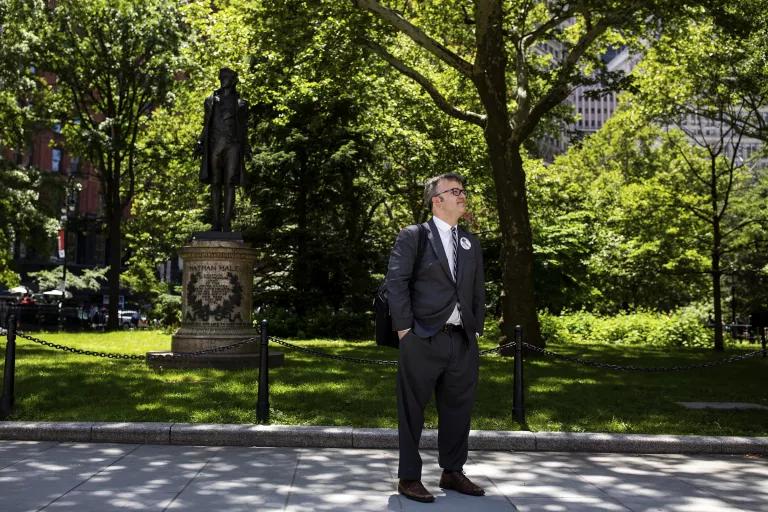
Lead organizer of Manhattan Together, Michael Stanley, waits before a community rally at City Hall.
Michael Stanley
Lead Organizer, Manhattan Together
Michael Stanley is no stranger to pursuing justice for those most in need. In his more than 15 years as an organizer with the IAF, he’s worked across New York City and on Long Island on a range of issues including addiction, special education, criminal justice, mental health, and, of course, public housing. When he started at Manhattan Together in July 2013, preparations to sue NYCHA were already in motion.
“We usually try to avoid litigation because of all the frustrations with how slow it is and how much time it takes,” Stanley says. “This issue is something we’d been organizing on in NYCHA complexes for decades—documenting specific problems, meeting everyone from the local property managers to the NYCHA chairperson—and we’d get some repairs, but it was never enough. It was always a fight. We never really got ahead of it,” he says.
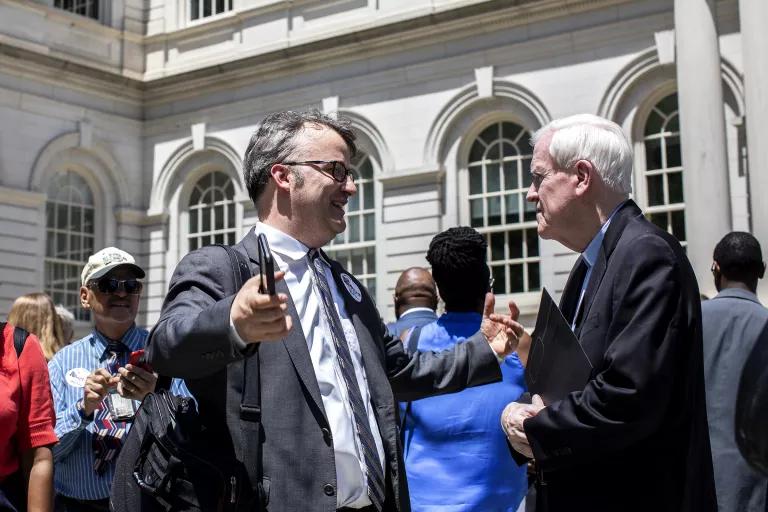
Stanley greets Reverand Francis Skelly, from the Immaculate Conception Church in the South Bronx, after the rally.
But the groundwork laid by the various local organizers—especially by the faith communities, he notes—was critical to bringing all the stakeholders together, and ultimately to the legal case’s success. “If you’re talking about collective action, you need a collective,” he says. Faith communities naturally foster a culture of group participation and offer a place where people can gather. Through their religious institutions, many NYCHA residents have come to meet others experiencing similar problems with mold and have developed the courage to share their stories.
Until now, Stanley says, NYCHA’s modus operandi has been this: “If you have access to power and can cause problems, you can get some results—not enough, but some. But if you are a tenant with no relationship and no access to power, you will get nothing. Not just on mold and leaks, but everything.” Still, he is hopeful about the sea change that the new settlement in the Baez case, as well as the U.S. Attorney’s recent actions, could bring—and not just for a lucky few. “Our goal is to ensure that all public housing tenants have the chance to live in decent conditions that don’t make them sick, no matter who they know,” he says. “We hope this new supervision and funding will help make that a reality.”
This NRDC.org story is available for online republication by news media outlets or nonprofits under these conditions: The writer(s) must be credited with a byline; you must note prominently that the story was originally published by NRDC.org and link to the original; the story cannot be edited (beyond simple things such as grammar); you can’t resell the story in any form or grant republishing rights to other outlets; you can’t republish our material wholesale or automatically—you need to select stories individually; you can’t republish the photos or graphics on our site without specific permission; you should drop us a note to let us know when you’ve used one of our stories.

How Can I Fix Mold and Lead Paint Issues in My House on a Small Budget?
Why We Need the EPA
The Particulars of PM 2.5